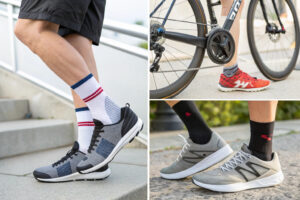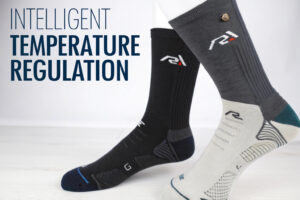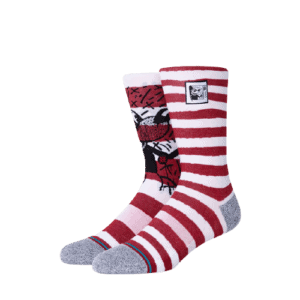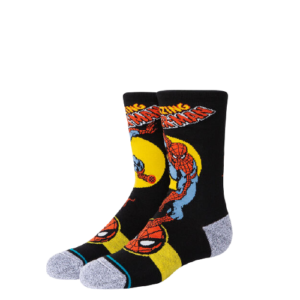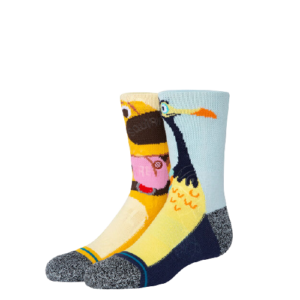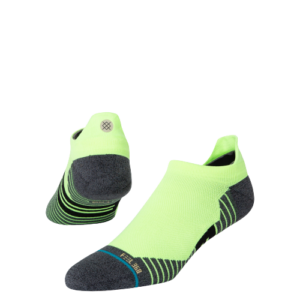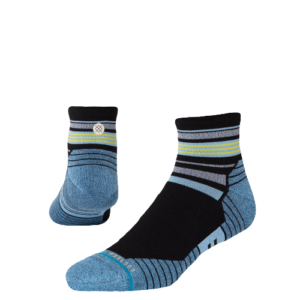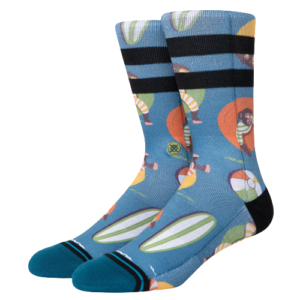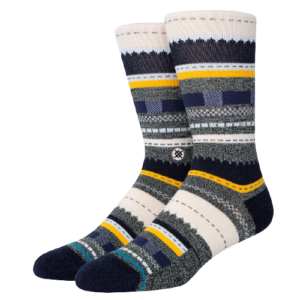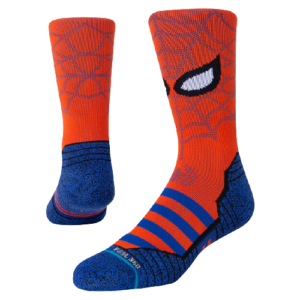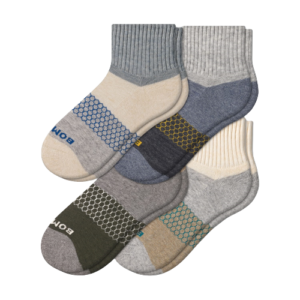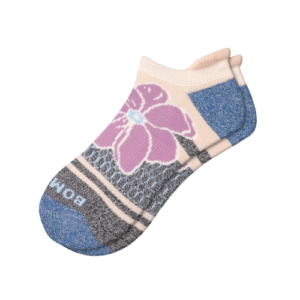Finding the right sock for different shoes is a common struggle. You want comfort and style, but often socks slip, bunch, or simply don't work with your footwear. This leads to frustration and a drawer full of socks you avoid.
Quarter socks often outperform no-show socks in shoe compatibility because they provide a more secure fit that prevents slipping in a wider range of footwear, especially athletic shoes and high-top sneakers. While no-show socks are designed to be invisible with low-cut shoes, they frequently slip off the heel, whereas quarter socks offer a balanced coverage that stays in place and enhances comfort during active use.
Understanding the strengths of each sock type is key to matching them with the right shoes. Let's explore the specific design features and practical scenarios where quarter socks provide a superior, hassle-free experience.
What are the key design differences between quarter and no-show socks?
The main problem when choosing socks is not knowing how their design affects your daily comfort. You might experience socks that constantly slip off or fail to provide adequate support.
The key design difference lies in the height and heel construction. No-show socks are designed to sit completely below the ankle bone. They often have a minimalistic design and sometimes feature small silicone grips or elastic bands on the inside of the heel to prevent slipping. Quarter socks, also known as mini-crew socks, extend several inches above the ankle, typically covering the ankle bone. This extra height provides a larger surface area for a secure fit, eliminating the need for additional grip strips that can wear out over time.

How does sock height influence shoe pairing?
Sock height is the most critical factor for shoe compatibility. No-show socks are intended for shoes with a low-cut collar, such as loafers, boat shoes, and some fashion sneakers. Their design aims to remain completely hidden. However, this very low profile is also their weakness; without sufficient fabric to grip the foot, they can easily slide down. Quarter socks, with their added height, are versatile. They pair well with a broader range of footwear, including athletic shoes, high-tops, and boots. The height ensures the sock stays in place during movement, making them a reliable choice for active wear. The American Apparel & Footwear Association provides extensive resources on footwear types and their history, which underscores the importance of matching accessories to shoe design.
What role does fabric and construction play in performance?
The fabric composition and construction methods differ to serve each sock's purpose. No-show socks often use very thin, lightweight materials like micro-modal or fine cotton blends to maintain their invisible profile. While this promotes breathability, it can sacrifice durability and cushioning. In contrast, quarter socks can utilize a wider variety of fabrics, including thicker organic cotton blends, merino wool, and performance materials with added spandex for better elasticity and arch support. The reinforced heel and toe areas in many quarter socks further enhance their longevity and comfort, making them a more robust option for daily use. For insights into performance textiles, the Textile Exchange offers information on material innovations that brands often leverage.
When should you choose quarter socks over no-show socks?
You face the daily decision of which sock to wear, and a wrong choice can lead to discomfort or ruined style. Knowing the right scenario for each sock saves you from this hassle.
Choose quarter socks for activities requiring movement and stability, and no-show socks for purely stylistic choices with specific low-cut shoes. Quarter socks are the superior functional choice for sports, walking, and wearing with shoes that have higher collars.

Are quarter socks better for athletic activities?
Absolutely. For any athletic activity, quarter socks are the clear winner. Their secure fit prevents them from slipping into your shoe, which can cause blisters. They also provide essential ankle coverage that protects against chafing from the shoe's collar. Whether you're running, playing basketball, or hitting the gym, the stability offered by a quarter sock enhances performance and comfort. The added fabric also allows for more technological features, such as targeted cushioning in the heel and ball of the foot, and moisture-wicking properties that keep your feet dry.
Do no-show socks work with all types of sneakers?
No, they do not. No-show socks are designed for a specific category of low-top sneakers and casual shoes. They struggle to stay on reliably with many types of athletic footwear that have a slightly higher cut. When worn with the wrong shoe style, the lack of grip and low height almost guarantees that they will slip off throughout the day. This makes them a risky and often uncomfortable choice for versatile sneaker collections that include both fashion and performance models.
How does heel grip technology prevent socks from slipping?
There's nothing more annoying than a sock that won't stay on your heel. This common issue can ruin the comfort of your favorite shoes.
Heel grip technology uses friction-enhancing materials, like silicone strips or elastic bands, to create a non-slip barrier between the sock and your skin. This technology is crucial for no-show socks, which lack the height to stay on naturally.

What are the common types of no-slip grips?
The most common type is a silicone grip band. This is a strip of medical-grade silicone printed or woven into the inside of the sock's heel and sometimes the toe area. The silicone creates a high-friction surface that clings to your foot. Another type is an integrated elastic band that wraps around the entire opening of the sock, applying gentle, even pressure to keep it in place. Some premium socks combine both methods for maximum security. However, the effectiveness of these grips can diminish after repeated washing, as the silicone can lose its adhesive quality.
Why do some grip technologies fail?
Grip technologies can fail for several reasons. Low-quality silicone may not adhere properly to the sock fabric, causing it to peel off after a few washes. Even high-quality grips can be defeated by excessive perspiration, which reduces friction. Furthermore, if the sock's overall construction is poor or the size is incorrect, no amount of grip technology will keep it from sliding down. A sock that is too large will bunch up, and one that is too small will stretch out and lose its elastic recovery, rendering the grips useless.
What are the long-term comfort and durability factors?
Investing in socks that wear out quickly is a waste of money. You need socks that maintain their shape, comfort, and functionality over time.
Quarter socks generally offer better long-term comfort and durability due to their robust construction and use of higher-quality, performance-oriented materials compared to the minimalist design of no-show socks.

How does material choice affect sock lifespan?
Material choice is a primary determinant of durability. No-show socks often use delicate, thin fabrics to remain invisible. These materials are more prone to pilling, thinning, and developing holes, especially in the heel area. Quarter socks can be made from more durable materials like combed cotton, reinforced nylon, and merino wool, which are known for their strength and resilience. The table below compares common materials:
| Sock Type | Common Materials | Durability Rating | Key Characteristics |
|---|---|---|---|
| No-Show Socks | Fine Cotton, Micro-modal, Thin Nylon | Low to Medium | Soft, lightweight, but less durable. |
| Quarter Socks | Combed Cotton, Merino Wool, Robust Nylon/Spandex blends | Medium to High | Strong, resilient, better abrasion resistance. |
Which sock type provides better value over time?
When assessing long-term value, quarter socks often come out ahead. Their durable construction means you won't need to replace them as frequently. The enhanced arch support, reinforced heels and toes, and better moisture management contribute to overall foot health and comfort, which is an invaluable benefit. While a no-show sock might have a lower initial cost, its shorter lifespan and higher likelihood of slippage can make it a less economical and satisfactory choice in the long run. Organizations like ASTM International set the global standards for textile durability that reputable manufacturers follow.
Conclusion
Choosing the right sock is more than a style decision; it's about ensuring all-day comfort and functionality. Quarter socks outperform no-shows in shoe compatibility by offering a secure fit, superior durability, and versatile performance across a wider range of footwear, especially for active use. While no-show socks have their place for specific low-cut styles, the quarter sock provides a reliable, comfortable solution you can count on.
If you are looking for a manufacturing partner to produce high-quality, durable quarter socks or any other hosiery product, we are here to help. Our expertise in functional materials and precise construction ensures your customers get the best. For a discussion on your specific needs, please contact our Business Director Elaine at elaine@fumaoclothing.com.



